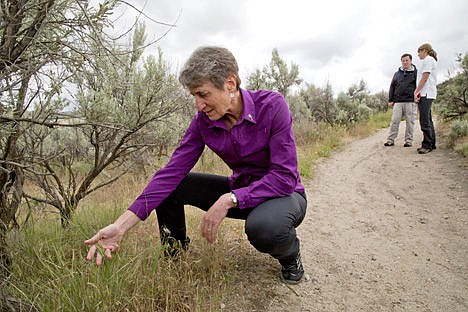Government releases fire plan to protect struggling bird
BOISE - A federal wildfire strategy released Tuesday aims to protect the West's sagebrush country which is home to a struggling bird species whose potential listing as a threatened or endangered species already has delayed energy projects and oil and gas deals.
Interior Secretary Sally Jewell was in Boise to announce the plan making greater sage grouse habitat a priority for fire prevention and response, focusing mainly on the Great Basin region of Idaho, Utah, Nevada, Oregon and California. The new strategy comes as the federal government and Western states scramble to implement plans meant to halt the decline of sage grouse populations and habitat without having to list the species as threatened or endangered. The U.S. Fish and Wildlife Service is under a court order to decide by Sept. 30 whether the sage grouse merits protections from the Endangered Species Act.
A bill passed by Congress in December would prevent the Fish and Wildlife Service from spending any money on protecting the bird, regardless of the agency's findings.
The report doesn't directly say whether money and resources would be shifted from other areas to better protect sage grouse habitat. Jewell addressed the issue by saying human lives come first in fire protection, but that homeowners near forested areas must do their part.
"The priority we have is still going to be for human life and property. But I will say this: That homeowners who are in the wildland-urban interface have a personal responsibility to make their houses fire-safe and defensible," Jewell said.
John Freemuth, a Boise State University professor and public lands expert, said it is important for government officials to show that making sage grouse habitat a priority won't mean a reduction in fire protection for other areas. "They've got to have a way to make it clear to the people on the ground, at least on the fire side of it, there will be less picking and choosing about which fires are important and which crews go where," he said.
Just the possibility of an Endangered Species Act listing has delayed the development of wind farms and the sale of oil and gas leases in areas occupied by the birds. Experts say the restrictions that would come with protecting the wide-ranging birds could damage the economies of the 11 states where they are found.
The 82-page Interior Department plan centers on how to prevent wildfires from consuming broad swaths of sage grouse habitat. The wildlife service's decision could be affected if there is widespread destruction during the upcoming fire season in a region where drought conditions are worsening.
Nearly 3.8 million acres of greater-sage grouse habitat has burned in the West since 2012, according to the Interior Department.
The strategy includes preventative measures to protect and rebuild sagebrush habitat, such as removing invasive weeds, building areas known as fuel breaks that have fewer flammable materials and replanting sagebrush. It also sets rural communities and landscapes as priorities for responding to fires, and it seeks to target funding and resources to "specific high value rangelands."
Idaho Gov. Butch Otter, who accompanied Jewell at Tuesday's announcement, said the new strategy would also benefit the cattle ranchers who occupy the Great Basin areas. "There isn't a rancher that I know of that hasn't expressed their interest, and not only that, but in many cases mobilized their own resources, in order to improve that habitat," Otter said.
Disease, oil and gas drilling, livestock grazing and wildfires are among the factors contributing to the sharp drop in greater sage grouse populations in recent decades.
Western states have already taken steps to protect sage grouse habitat, from restrictions on energy development near the bird's breeding grounds to suspending hunting seasons.
Regardless of the fish and wildlife service's findings in September, Jonathan Oppenheimer of the Idaho Conservation League said he believes the efforts to protect sage grouse will continue.
"I think that there is little doubt - whether it is a rancher or land owner or energy developers or the mining industry or others - that they recognize these threats that are posed to sage grouse," Oppenheimer said.
Volz reported from Helena, Montana.

